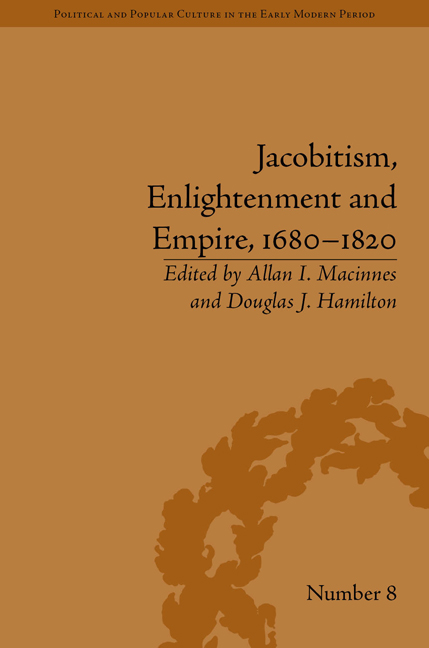Book contents
- Frontmatter
- CONTENTS
- List of Contributors
- List of Tables
- Introduction: Identity, Mobility and Competing Patriotisms
- 1 Jamie the Soldier and the Jacobite Military Threat, 1706–27
- 2 Simply a Jacobite Heroine? The Life Experience of Margaret, Lady Nairne (1673–1747)
- 3 Missionaries or Soldiers for the Jacobite Cause? The Conflict of Loyalties for Scottish Catholic Clergy
- 4 English Liturgy and Scottish Identity: The Case of James Greenshields
- 5 ‘Let Him be an Englishman’: Irish and Scottish Clergy in the Caribbean Church of England, 1610–1720
- 6 Scotland, the Dutch Republic and the Union: Commerce and Cosmopolitanism
- 7 Clearing the Smokescreen of Early Scottish Mercantile Identity: From Leeward Sugar Plantations to Scottish Country Estates c. 1680–1730
- 8 Union, Empire and Global Adventuring with a Jacobite Twist
- 9 John Drummond of Quarrel: East India Patronage and Jacobite Assimilation, 1720–80
- 10 William Playfair (1759–1823), Scottish Enlightenment from Below?
- 11 The Visionary Voyages of Robert Burns
- 12 ‘Defending the Colonies against Malicious Attacks of Philanthropy’: Scottish Campaigns against the Abolitions of the Slave Trade and Slavery
- Abbreviations
- Notes
- Index
12 - ‘Defending the Colonies against Malicious Attacks of Philanthropy’: Scottish Campaigns against the Abolitions of the Slave Trade and Slavery
- Frontmatter
- CONTENTS
- List of Contributors
- List of Tables
- Introduction: Identity, Mobility and Competing Patriotisms
- 1 Jamie the Soldier and the Jacobite Military Threat, 1706–27
- 2 Simply a Jacobite Heroine? The Life Experience of Margaret, Lady Nairne (1673–1747)
- 3 Missionaries or Soldiers for the Jacobite Cause? The Conflict of Loyalties for Scottish Catholic Clergy
- 4 English Liturgy and Scottish Identity: The Case of James Greenshields
- 5 ‘Let Him be an Englishman’: Irish and Scottish Clergy in the Caribbean Church of England, 1610–1720
- 6 Scotland, the Dutch Republic and the Union: Commerce and Cosmopolitanism
- 7 Clearing the Smokescreen of Early Scottish Mercantile Identity: From Leeward Sugar Plantations to Scottish Country Estates c. 1680–1730
- 8 Union, Empire and Global Adventuring with a Jacobite Twist
- 9 John Drummond of Quarrel: East India Patronage and Jacobite Assimilation, 1720–80
- 10 William Playfair (1759–1823), Scottish Enlightenment from Below?
- 11 The Visionary Voyages of Robert Burns
- 12 ‘Defending the Colonies against Malicious Attacks of Philanthropy’: Scottish Campaigns against the Abolitions of the Slave Trade and Slavery
- Abbreviations
- Notes
- Index
Summary
In narratives of the great abolition campaigns of the late eighteenth and early nineteenth centuries, Scots often appear as powerful anti-slavery advocates. Scots churchmen and intellectuals (like James Beattie) pronounced against slavery for moral reasons while others, notably Adam Smith, attacked it as an archaic and inefficient economic system. Zachary Macaulay and William Dickson were active and high profile members of the central abolition campaign, which mobilized public outrage against a dreadful institution. The work of these and less well-known individuals encouraged Scots of all stamps to announce their opposition to slavery from the later eighteenth century through petitions, public meetings and the purchase of anti-slavery merchandise. As a result, an image has emerged of Scotland and of Scots as ‘abolitionist’ that in many ways conforms to, and even goes further than, a wider British view of itself as the world's great anti-slavery nation, its vast slave holdings notwithstanding. Nonetheless, amidst the deluge of parliamentary petitions clamouring for an end to the slave trade and then for emancipation, other Scottish voices, which argued for the retention of the trade and slavery, remained audible throughout the fifty-year long abolition campaigns.
This chapter examines these anti-abolitionist responses to the campaigns against, firstly, the slave trade and, secondly, against slavery itself. In doing so, the chapter shows three things. Firstly, it argues that anti-abolitionism was organized and disseminated through networks of West India planters and merchants and their allies.
- Type
- Chapter
- Information
- Jacobitism, Enlightenment and Empire, 1680–1820 , pp. 193 - 208Publisher: Pickering & ChattoFirst published in: 2014

